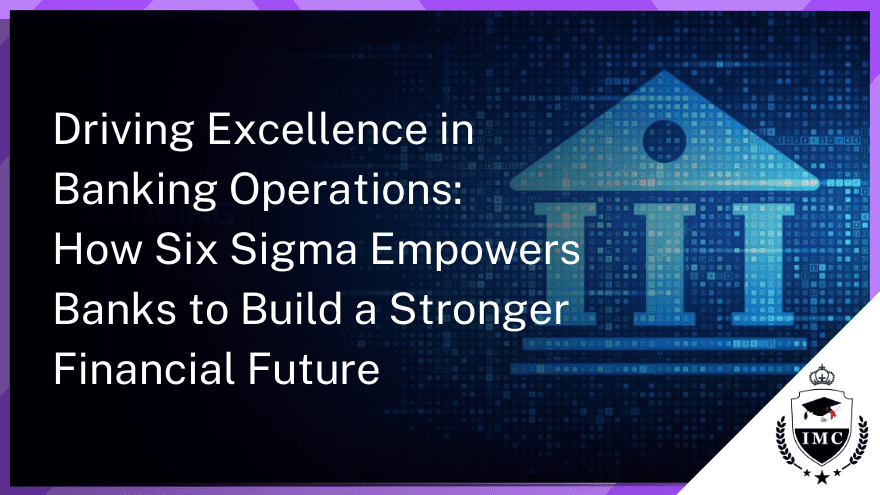The banking industry is facing immense challenges - fintech disruptors are entering the scene, customers expect extremely high levels of service, and the environment is increasingly competitive and complex. Banks need to operate at peak efficiency and effectiveness to succeed. This is where Six Sigma comes in. Six Sigma is a proven quality management methodology that relies on statistical analysis and a structured approach to eliminate defects and variability across processes. It has a long track record of driving remarkable improvements across industries. In this blog post, we will explore in detail how Six Sigma can enable banks to enhance customer experience, reduce costs, manage risks more effectively, and gain a competitive edge. We will provide a thorough overview of Six Sigma concepts and tools, highlight the major benefits Six Sigma offers banking, and illustrate real-world examples of Six Sigma in action to transform banking operations. For any bank looking to improve performance, customer satisfaction, and competitive positioning, embracing Six Sigma may be the answer.
What is Six Sigma?
Six Sigma is a data-driven methodology focused on continuous improvement by minimizing defects and maximizing efficiency. It utilizes a DMAIC (Define, Measure, Analyze, Improve, Control) cycle to identify and eliminate process variations that lead to errors and inefficiencies. Benefits of Six Sigma in Banking:
Overview of Six Sigma:
- Before looking at Six Sigma in banking, let’s examine some key concepts:
- Methodology to improve processes by reducing variability
- Follows five phases - Define, Measure, Analyze, Improve, Control (DMAIC)
- Uses data and statistical tools to guide decisions
- Focuses on achieving near perfection rate of 99.99966%
- Relies on belt system of trained specialists - Green, Black, Master Black
- Requires management vision and commitment to succeed
- With these fundamentals, Six Sigma is ready to work its magic in banking.
Applying Six Sigma in banking processes and operations:
Improved customer experience - By smoothing processes and minimizing defects, Six Sigma raises customer satisfaction. This builds loyalty.
Reduced costs - Eliminating rework, errors, and waste cuts costs substantially. Streamlined processes also lower operating costs.
Management of risk - Six Sigma identifies and monitors variability that causes risk. Fixing these minimizes overall risk exposure.
Increased efficiency - Optimized processes help improve productivity and timeliness. This boosts bank output and throughput.
Competitive advantage - Leading banks use Six Sigma to be at the forefront of service quality and efficiency. It’s a competitive differentiator.
Enhanced analytics - Statistical tools and data-driven decisions sharpen analysis capabilities across the bank.
Clearly, Six Sigma delivers immense value at multiple levels for banks.
Six Sigma in Action in Banking:
To see Six Sigma’s banking benefits first-hand, let’s look at some examples:
Improving mortgage approval times - By mapping out the approval process, reducing redundant steps, and automating tasks, approval times were cut by over 35%.
Minimizing errors in account statements - Applying statistical process control revealed correlations between employee fatigue and statement errors. Revamping schedules reduced errors by 71%.
Optimizing branch layouts - DOE experiments found the branch layout best suited for customer experience and teller productivity. The optimal layout improved satisfaction scores and capacity by double digits.
Reducing call center wait times - Wait times were lowered by 22% through process changes like balancing call routing and smoothing caller authentication.
Decreasing loan application defects - Defect analysis and poka-yoke preventions were instituted to avoid common loan application issues. This minimized rework and raised approvals.
Six Sigma for Individual Career Advancement
While Six Sigma primarily benefits organizations, individuals seeking a stronger financial future can also benefit from acquiring this valuable skill set. Here's how:
Increased Employability: Having a Six Sigma certification demonstrates your commitment to continuous improvement and efficiency, making you a more attractive candidate to potential employers in the banking and other industries.
Higher Earning Potential: Individuals with Six Sigma certifications often command higher salaries due to their specialized skills and the value they bring to organizations.
Stronger Career Growth: Six Sigma expertise demonstrates your ability to think critically, solve problems, and implement data-driven solutions. This can open doors to new career opportunities and leadership positions within the financial sector.
Six Sigma Training and Certification Levels
Six Sigma Green Belt Certification (GB):
Actively involved in Six Sigma projects while fulfilling their regular banking responsibilities. Apply Six Sigma methodologies and tools to support process improvements and defect reduction. Collect and analyze data, identify root causes of issues, and propose solutions. Collaborate with Black Belts and provide input for project implementation.
Six Sigma Black Belt Certification (BB):
Expert problem solvers and project leaders who drive Six Sigma initiatives within banking processes. Lead DMAIC projects to identify, analyze, and improve critical processes. Utilize statistical analysis and data-driven approaches to achieve significant improvements in efficiency and quality. Train and mentor Green Belts and assist in their project execution.
Six Sigma Master Black Belt Certification (MBB):
The visionary leaders and strategists behind the implementation of Six Sigma in the banking industry. Responsible for developing overarching Six Sigma strategies aligned with organizational goals. Provide guidance and mentorship to Green Belts, Black Belts, and management teams. Oversee the successful execution of Six Sigma projects and ensure sustained improvements.
Why Choose IMC Institute for Your Six Sigma Certification Journey?
At IMC Institute , we offer comprehensive Six Sigma Certification programs designed to equip you with the knowledge and skills you need to excel in the banking industry and beyond. Our highly qualified instructors, combined with our practical and interactive learning approach, ensure you gain a thorough understanding of Six Sigma principles and their application in real-world scenarios.
These real-world examples showcase Six Sigma’s power to transform banking for the better.
Summary:
In summary, this blog post covered how Six Sigma, with its data-driven approach to minimize variability and defects, can power major improvements for banks. We explained the core concepts of Six Sigma, including its DMAIC method, use of statistical tools, and focus on near perfection. Several compelling benefits were highlighted – optimized customer experience, lower costs, effective risk management, increased efficiency and productivity, strengthened analytics, and competitive advantage. Real-world case studies of Six Sigma in banking provided tangible examples of how it can transform approval times, minimize errors, optimize branch layouts, reduce call center waits, and decrease loan defects. The post makes it clear that to meet today’s challenges, compete at the highest level, and build a stronger financial future, banks should seriously consider adopting Six Sigma. Its track record of driving excellence makes it an ideal fit for the banking indust






